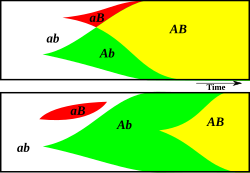
Clonal interference is a phenomenon in evolutionary biology, related to the population genetics of organisms with significant linkage disequilibrium, especially asexually reproducing organisms. The idea of clonal interference was introduced by American geneticist Hermann Joseph Muller in 1932.[1] It explains why beneficial mutations can take a long time to get fixated or even disappear in asexually reproducing populations. As the name suggests, clonal interference occurs in an asexual lineage ("clone") with a beneficial mutation. This mutation would be likely to get fixed if it occurred alone, but it may fail to be fixed, or even be lost, if another beneficial-mutation lineage arises in the same population; the multiple clones interfere with each other.
- ^ Gerrish PJ, Lenski RE (1998), "The fate of competing beneficial mutations in an asexual population", Mutation and Evolution, vol. 102–103, no. 1–6, Springer Netherlands, pp. 127–144, doi:10.1007/978-94-011-5210-5_12, ISBN 9789401061933, PMID 9720276